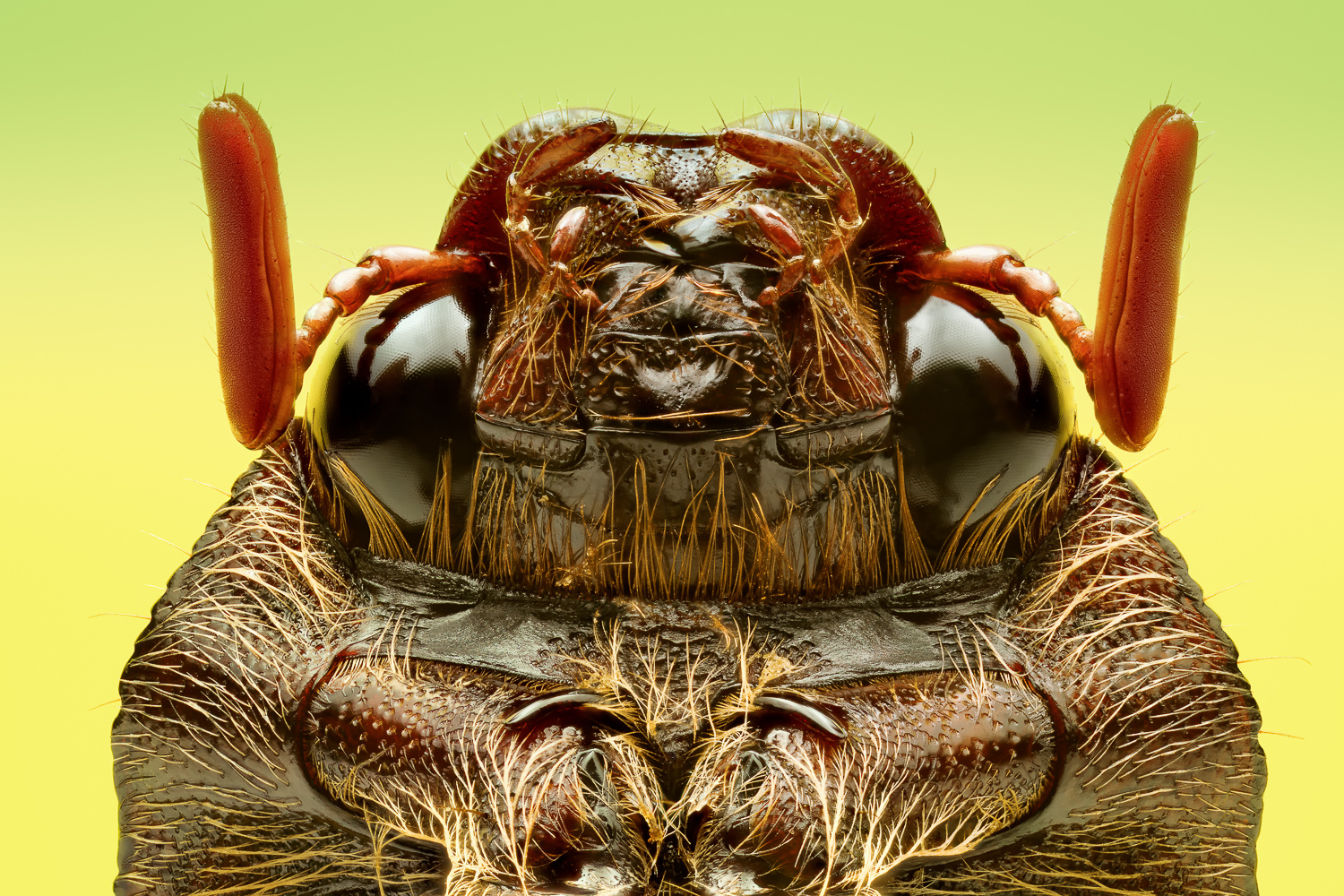
Pogonomyrmex barbatus @ 10X
High magnification (10x) Stack of Red Ant. Full frame image, no crop, representing 3.6mm x 2.4mm.
For the techies - details as follows:
Canon 5D-III, MT-24EX Flash, DIY styrofoam bowl diffuser, Vivitar 3.5 200mm "tube" lens (old manual film lens), and Nikon 10x/.25 ∞ microscope objective. 5µm stack steps for a total of 369 images substacked in Zerene (batches of 20 with 10 image overlap), heavy halo cleanup in Zerene and Photoshop.
Lessons learned - pick shallower stacks with hairy subjects, cleanup is a real bear. If you look close you will see some jagged edges on some of the hairs. I'll revisit this at a later date. Limit foreground overlap (antenna in this case).Stacking software has a hard time determining what is foreground and background. In this photo it caused the antenna to take on a translucent ghosting effect. I had to substack (slab) antenna by itself and blend into background stack. Really hard to get decent blend results. Another issue is background detail near the antenna is lost due to the lens focusing "through" it. While the Zerene is good for retouching, I found final cleanup of dark halos and minor detail blends most effectively handled in Photoshop.
All in all it was a worthwhile exercise and I produced an acceptable image. I look forward to doing another subject and seeing how I can improve my technique/final image.

Winter Stacking Blues
Time to clean out the freezer. My friends are all very aware of my passion for macro photography. There isn't a weekend that goes by that I'm not out in the field photographing insects and such. That said, several of my friends feel compelled to collect dead subjects they find and gift them to me. I gladly accept the gracious offers, put them in a jar and pop 'em in the freezer until I have time to photograph them. Often the specimens are too damaged to photograph in their entirety, I have bits of legs, wings, heads, etc so I try to focus in on a portion of the remnants I find interesting. In the case of this Shield bug nymph most of the legs were damaged beyond repair so hydrating and pinning them in position was out of the question. I did find myself inexplicably drawn to the shell - the colors and textures. It was very dusty and dirty so I ran it in a warm soapy water bath and cleaned it up with the aide of a stereo microscope, very fine entomology pins, and fine (like 3 hairs) paint brushes.
Image Specs: Canon EOS-M(uch maligned original version), Canon FL Bellows (60's/70's version), Rodenstock Rodagon N 50mm f/2.8 APO reversed @ 3.5:1, Diffused (paper towel) Strobe 128 image stack / Processed in Zerene and and some dust and speck cloning in Lightroom.

June Bug - Rhizotrogus majalis - Stack
This is a European chafer, the bane of fine upstanding southern lawns throughout the United States. As a child I was fascinated by these beetles and would keep them in shoe boxes with plastic wrap windows.
Despite the nickname “June Bug” the beetles often come out as early April, as was the case with the subject. Life span of the adult (beetle) is short, usually last a couple of weeks. It’s a nocturnal insect and often morning light reveals my back patio littered with carcasses from spring through early fall.
For photography purposes the colors are rather bland but the insect is rich with textures and details, which make them interesting for me to photograph. First tabletop insect stack I ever did was of a June Bug so this is also a good comparison photo to see how much my technique has progressed over the past two years.
Image specs: Sixty Image Stack on Tabletop Rig - Canon 5D-III, MP-E 65mm @3.5:1 - f/4 - SS 1/40 - ISO100 - Canon MT24-EX flash at 1/8 power with DIY triangular diffuser. Stacked in Zerene with cleanup in Photoshop.
Table Stacks



